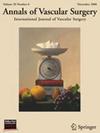iCAST桥接支架在顶顶开孔内移植物中的效果-单中心经验
IF 1.4
4区 医学
Q3 PERIPHERAL VASCULAR DISEASE
引用次数: 0
摘要
背景:评估在Zenith开窗内植(ZFENs)开窗血管内动脉瘤修复(FEVAR)中放置球囊可扩张iCAST桥架的患者的结果,并确定支架相关并发症的术前和围手术期危险因素。方法在2012年至2020年期间,207例患者使用未修饰的ZFEN与icast覆盖的支架桥接内脏靶血管进行FEVAR。我们收集了患者的人口统计数据和手术变量。我们收集了内部渗漏、分支通畅和再介入的长期随访数据。我们将支支架并发症定义为监测成像研究确定的不对准、扭结、闭塞或需要干预的内漏。我们比较了有支架并发症患者和无支架并发症患者指数手术的变量,以确定重要的危险因素。结果本组患者以男性(158例,76.3%)、白人(199例,96.1%)为主,并伴有心血管合并症。大部分的修复是针对鞍旁动脉瘤(n = 149, 72%),其余的修复进一步延伸到头部。我们在随访中发现了23例需要再介入治疗的搭桥支架并发症患者。并发症组更常使用肱通道(34.8% vs. 15.8%, P = 0.0251)。并发症组治疗IV度胸腹主动脉瘤(TAAAs)的比例显著高于并发症组(17.8% vs. 5.4%, P = 0.0316)。比较分支并发症组和无分支并发症组的其他患者特征和围手术期因素。提出了无干预通畅的Kaplan-Meier图。结论:在此,我们介绍了一项大型单一机构在FEVAR期间使用未修改的ZFEN和支架相关并发症的危险因素进行iCAST分支支架的经验。有分支并发症的患者更可能有肱通道和更广泛的动脉瘤修复。大多数分支并发症在前2年内被发现,其中一半的再干预发生在指数手术后7.5个月内。本文章由计算机程序翻译,如有差异,请以英文原文为准。
Outcomes of iCAST Bridging Stents in Zenith Fenestrated Endografts – A Single Center Experience
Background
To evaluate the outcomes of patients undergoing placement of balloon-expandable iCAST bridging stents during fenestrated endovascular aortic aneurysm repair (FEVAR) with Zenith Fenestrated Endografts (ZFENs) and to identify preoperative and perioperative risk factors for stent-related complications.
Methods
Between 2012 and 2020, 207 patients underwent FEVAR using unmodified ZFEN with bridging iCAST-covered stents to visceral target vessels. We collected patient demographics and operative variables from the index repair. We collected long-term follow-up data for endoleaks, branch patency, and reintervention. We defined branch stent complications as malalignment, kinking, occlusion, or endoleak requiring intervention as determined by surveillance imaging studies. We compared variables from the index operation in those patients with stent complications to those patients without stent complications to identify significant risk factors.
Results
Patients in our cohort were predominantly male (n = 158, 76.3%), White (n = 199, 96.1%), and demonstrated cardiovascular comorbidity. The majority of repairs were for juxtarenal aortic aneurysms (n = 149, 72%) with the remainder of repairs extending further cephalad. We identified 23 patients with bridging stent complications during follow-up that required reintervention. Brachial access was more frequently used in the complication group (34.8% vs. 15.8%, P = 0.0251). A significantly higher proportion of patients in the complication group was treated for extent IV thoracoabdominal aortic aneurysms (TAAAs) (17.8% vs. 5.4%, P = 0.0316). Additional patient characteristics and perioperative factors are compared between the branch complications and no branch complications groups. An intervention-free patency Kaplan-Meier plot is presented.
Conclusion
Here, we present a large single institution experience with iCAST branch stents during FEVAR using unmodified ZFEN and risk factors for stent-related complications. Patients with branch complications were more likely to have brachial access and more extensive aneurysm repair. Most branch complications were identified within the first 2 years, with half of reinterventions occurring within 7.5 months of the index operation.
求助全文
通过发布文献求助,成功后即可免费获取论文全文。
去求助
来源期刊
CiteScore
3.00
自引率
13.30%
发文量
603
审稿时长
50 days
期刊介绍:
Annals of Vascular Surgery, published eight times a year, invites original manuscripts reporting clinical and experimental work in vascular surgery for peer review. Articles may be submitted for the following sections of the journal:
Clinical Research (reports of clinical series, new drug or medical device trials)
Basic Science Research (new investigations, experimental work)
Case Reports (reports on a limited series of patients)
General Reviews (scholarly review of the existing literature on a relevant topic)
Developments in Endovascular and Endoscopic Surgery
Selected Techniques (technical maneuvers)
Historical Notes (interesting vignettes from the early days of vascular surgery)
Editorials/Correspondence

 求助内容:
求助内容: 应助结果提醒方式:
应助结果提醒方式:


